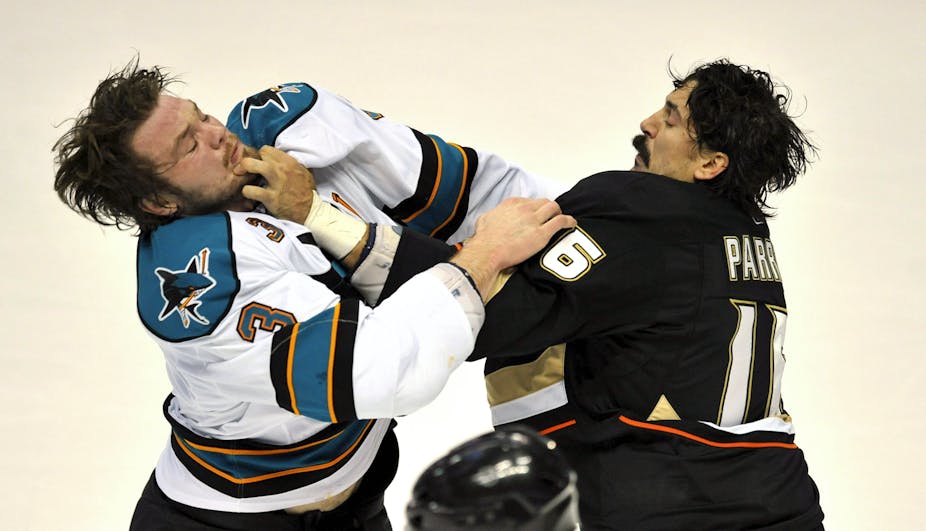The multi-million dollar settlement of damages from one of the National Hockey League’s most famous punches is a reminder that violent incidences rarely come to the attention of the courts, though they are inherent in contact sports.
The punch in question occurred a decade ago during a NHL game between the Vancouver Canucks and the Colorado Avalanche franchises. The Canuck’s Todd Bertuzzi struck Colorado’s Steve Moore from behind and drove his face onto the ice. The injuries suffered by Moore, three fractured vertebrae and a concussion, ended his career.
The TV clips from the game on March 8 2004 still make for uncomfortable viewing. A noticeable feature of the accompanying commentary is how often mention is made of Moore being targeted, in sporting parlance, for “attention” by members of the opposing team.
Later it would emerge that Bertuzzi was acting in retribution for a punch thrown by Moore in a previous game between the clubs which had left Canuck captain Markus Maslund bloodied and concussed. The vigilante nature of violence in ice hockey and the mantra of “what happens on the ice should stay on the ice” are themes that would run through the subsequent sporting, civil and criminal law proceedings.
The immediate reaction in Canada to Bertuzzi’s punch was unusually and vociferously negative. Paul Martin, prime minister at the time, said: “I think that Canadians feel that there is a problem with hockey. I’d certainly say: clean up your act.”
Bertuzzi received one of the longest suspensions in NHL history, missing the reminder of the 2003-4 season and losing about C$500,000 in forfeited salary. More unusually still is that he faced both a criminal prosecution and a civil claim.
The law and sporting violence
Legal sanction for sporting violence is extremely rare. There are many reasons for this: sports governing bodies are trusted through their rules to contain physically invasive conduct to an acceptable level; participants are seen voluntarily to consent to these rules; and sports-specific, as opposed to legal, sanctions are seen as a more effective means of punishing a misbehaving player.
Occasionally, however, an act of player on player violence is so egregious that there must be legal repercussions. This was one such occasion.
In December 2004, Bertuzzi pleaded guilty to a charge of assault causing bodily harm and was sentenced to one year probation and 80 hours of community service. In 2006, Moore initiated a civil action for damages arising out of the career-ending assault. The proceedings were plagued by delay relating to a dispute over the medical evidence and by Bertuzzi’s plea that, given his profile and the intense media coverage on both sides of the North American border, he was unlikely ever to receive a fair trial.
Eventually a trial date was set for September of this year but this week the parties indicated that a confidential settlement had been reached. The trial would have been interesting for a number of reasons, including the insight it would have given into the sport’s dressing room culture. A disputed feature of the Bertuzzi-Moore incident has always been whether there was a premeditated plan by the Canuck players and coaching team to target Moore. And, if there had been, should the Canuck club be vicariously liable in damages for the actions of their employee.
Another point of interest would have been how the damages were assessed. Moore’s initial civil claim was for almost C$40m in damages. The damages were benchmarked against his three factors: Moore’s continuing medical expenses, the C$30m that Peruzzi has earned in salary in the decade since the assault, and the fact that Moore, a Harvard graduate, has had difficulty obtaining employment since the incident.
NHL liability
The third point of interest is that key administrators in the NHL were due to be questioned on whether the NHL is properly discharging its duty of care toward players to ensure their safety on the rink and particularly with respect to head injuries.
This last point is of wider interest because the NHL is currently being sued by a number of retired players who allege that the league knew or should have known about the dangers posed by concussion and had failed to mitigate the risks involved. In that claim, the players specifically mention the NHL’s potential liability for “refusing to ban fighting and body checking and by continuing to employ hockey players whose main function is to fight or violently body check players on the other team”.
This suit is of immediate concern to the NHL, given that the National Football League has now agreed to a US$750m in settlements with retired American footballers who were hurt while playing. In the longer term, however, the “chilling effect” of litigation from injured players should be of greater concern to the NHL.
Although NHL revenues are currently buoyant, due mainly to a lucrative TV deals, the NHL must realise that there is a diminishing return in tolerating an ethos of enforcers and fighters. Indeed, participation levels at the entry level to the sport are falling, as parents appear dissuaded by the violence of the game.
In a lesson that should be heeded by all contact sports, it seems that for too long the NHL has played the man and not the puck and is now paying the price.

